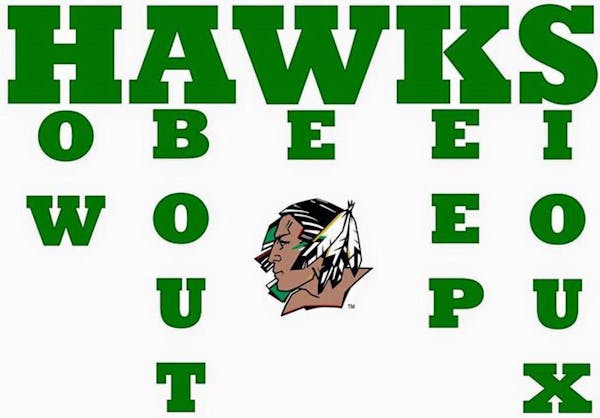At a football game several years ago, when he was the new superintendent of Sleepy Eye Public Schools, John Cselovszki heard with dismay that some of the rival team's fans had used the tomahawk chop to antagonize his school's football team, the Indians.
Even though Sleepy Eye has few American Indian residents — the most recent census suggests fewer than five of 3,599 locals are Indian — the chop was offensive and required Cselovszki to lodge a complaint with the opponent's superintendent.
"It's important," said Cselovszki, who has embraced the city's admiration for Chief Ish-Tak-Ha-Ba, or "Sleepy Eyes," represented by a towering granite memorial, a statue and the school's logo, which is an ink drawing of the long-deceased chief.
This week, the University of North Dakota announced it will drop its Fighting Sioux nickname to become the Fighting Hawks, bowing to public pressure to abandon its Indian-themed nickname. But in Minnesota, a handful of public schools continue the practice, sometimes with the blessings of local Indians.
In Warroad, the Warriors will take to the ice this year in search of another state hockey title. In Benson, the Braves just finished their football season. Another three or four schools in or near Indian reservations — all of them with majority populations of Indians — use Indian-themed logos or nicknames. The schools seem unlikely to change, because in many cases, Cselovszki and others pointed out, it's a matter of context and history, with some of the schools pointing to significant Indian history in their backyards.
Most of the schools that had scant claim to Indian culture dropped Indian-themed mascots or logos starting in 1989, when the Minnesota Civil Liberties Union and the state Department of Education made a first-of-its-kind request that schools do so. Some 56 schools statewide that year were known as the Indians, Chiefs, Warriors, Mohawks and Redmen, among other names.
Today, it's just Sleepy Eye, Warroad and Benson, along with a few reservation schools.
Cselovszki, who is both superintendent and elementary principal of Sleepy Eye Public Schools, said the high school's logo honors the city's namesake.
Chief Ish-Tak-Ha-Ba died around 1859 but remains an important figure locally. His remains were buried beneath a granite monument in town. Four years ago, his great-great-great-great granddaughter donated his pipe to the Sleepy Eye Area Historical Society in a ceremony that drew local press.
At Sleepy Eye high school, a welcome sign above the front entrance reads "Home of the Indians" along with the school's logo. The Indians team name is painted on the school's bleachers and printed on team jerseys.
"We are honoring the chief, by carrying his name," Cselovszki said.
At Mahnomen public schools, where a majority of students are Indian, "it's always been a sense of pride" to be called the Indians, said Superintendent Jeff Bisek. The school's logo looks like a dreamcatcher with the word "Indians" across the top.
The athletic director surveyed students recently about the nickname and students were "pretty much 100 percent" for it, said Bisek. In 2012 and 2013, when the Mahnomen football team won state championships, the local tribal council helped the school celebrate by buying meals and T-shirts for the players, Bisek said.
History matters
The National Coalition Against Racism in Sports and Media has no issue with communities that want to keep their names as long as there's an underlying reason that makes sense, said Henry Boucha, the group's vice president.
It's a matter of history, he said, pointing to his own hometown of Warroad.
The school's mascot, according to Boucha, came out of a land deal in the early 20th century when a descendant of a local chief sold some of his land so that Warroad could build a school. The Warriors nickname was chosen to honor the area's history, he said. The school logo was designed by local Indian parents.
"It's an honorable kind of situation," he said.
Boucha carries an unusual degree of authority in both Indian circles and in hockey-crazed Warroad. A member of the Northwest Angle band of Ojibwe, he helped lead the 1969 Warriors hockey team to the state finals before going on to play in the 1972 Olympics and in the National Hockey League. He was inducted into the U.S. Hockey Hall of Fame in 1995.
It was Boucha last year who explained the significance of the Warriors' name when the National Coalition Against Racism in Sports and Media was considering a lawsuit against the Warroad School District. The logo and team nickname were instead rededicated last year in a ceremony featuring Indian drummers.
Boucha said the coalition continues to press for changes to sports team names, especially for the Washington Redskins, since there's no connection between the team and a native community.
"It's a derogatory name; it needs to be changed," he said.
The movement against high school Indian mascots gained another ally this month when Adidas announced it would help schools change mascots by providing logo design and financial assistance for new uniforms. An Adidas spokeswoman said 80 schools nationwide have taken up the offer since it was announced Nov. 5.
"It's wonderful," said Boucha. "We're gaining support week after week, month after month."
Matt McKinney • 612-217-1747

Trail section at one of Minnesota's most iconic spots closing for rehab

Will 'shotgun only' zone for deer in southern Minnesota be abolished?

Four Minnesotans catch salmonella in outbreak linked to basil sold at Trader Joe's

